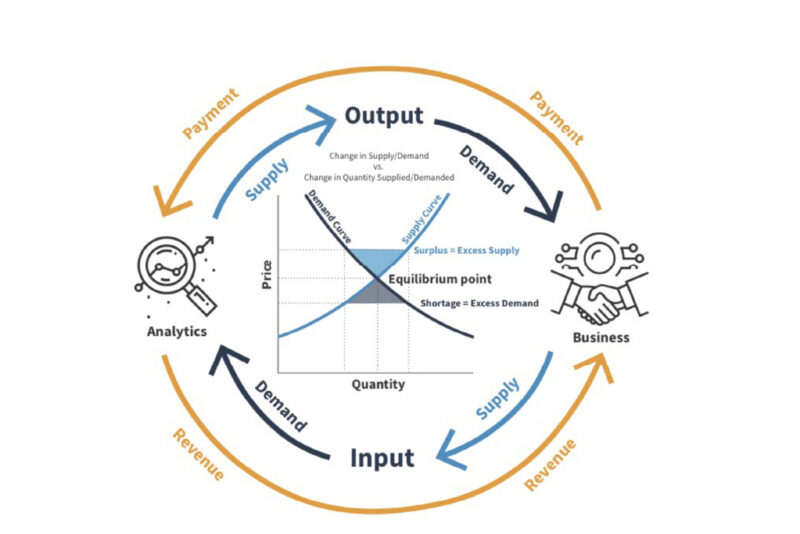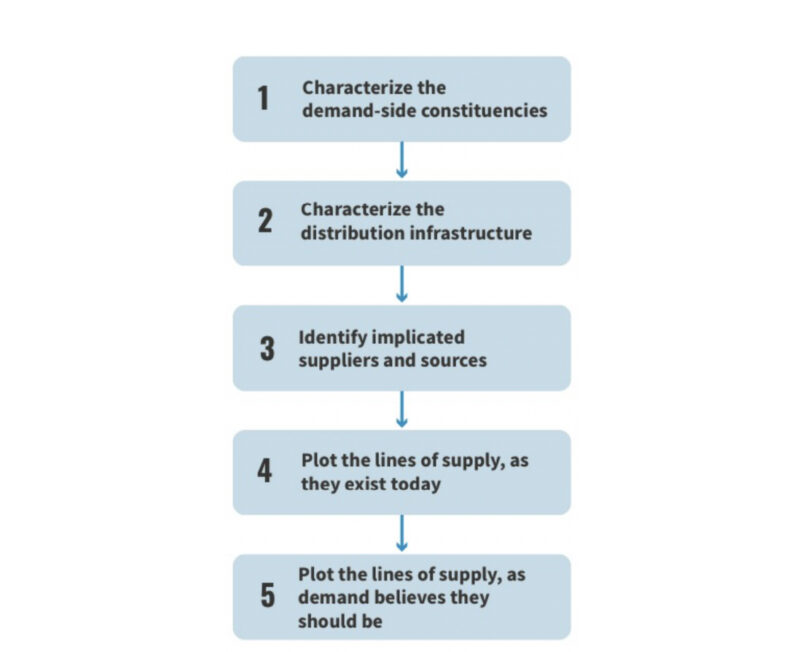
Earlier in the year Chris Donavan, chief data and information officer at Medical Mutual Ohio, joined me in a webinar discussion on IIA’s principles for analytics maturity and the power of assessing the data consumers and producers in your enterprise on a consistent basis. I could think of no better person to join me in this discussion. Chris and his team has been a part of IIA’s community for many years and has implemented our analytics maturity assessments several times over—he knows our modus operandi better than anybody.
It was a pleasure taking the virtual stage with Chris and hearing new stories about his experience as a data and analytics leader. As IIA internally plans for 2024, I’ve been reflecting on the key takeaways of my conversation with Chris, and I think it’s worth lingering on them for awhile. So, I plan to explore these principles in a series of articles to help data and analytics leaders define their analytics and AI strategy and make the right moves toward progress. As always, we’d love to hear feedback along the way.
First, let’s review the five principles that drive IIA’s thinking and approach to serving our clients in their transition to advanced analytics and AI.
- Every firm is a unique information economy.
- Demand always gets its needs met, one way or another.
- World-class supply cannot deliver business value without collaboration with demand.
- Data and analytics excellence (i.e. high maturity) occurs with balance and harmony between supply and demand.
- The highest analytics performers measure progress consistently using the same objective methodology.
In our view, you must understand and act on these principles to stand up and sustain a high-performing data and analytic organization. Ignoring or disregarding these principles will contribute to a lack of progress and repeated mistakes.
IIA’s thinking about the problems and accomplishments with data and analytics in enterprises is very much rooted in the governing laws of economics. This gives us a framework that explains human behavior as it relates to producing and consuming data and analytics and a backdrop that intuitively makes sense to the business.
Through thousands of client engagements spanning more than a decade, we see the fundamental problem with most analytics initiatives is that they are quite often undertaken in an under-characterized context.
In establishing enterprise analytics programs, data and analytics leaders often initially focus on technology, processes, and business objectives to achieve analytical transformations. Most leaders neglect to factor in cultural state and structuring, assuming implicitly that all organizational cultures are equally capable of supporting the transformation they wish to accomplish—all they have to do is plug in and go.
What data and analytics leaders neglect to characterize, and what becomes a source of their efforts’ frustration or failure, is their organization’s naturally occurring information economy, with its own history, characteristics and (dys)functions—i.e., the dynamic between supply and demand, and the market infrastructure that supports or thwarts demand’s quest for supply.

In this post, I will outline a five-step process for analyzing and characterizing the unique information economy that lies at the base of your analytics initiative’s effectiveness. If you remember nothing else, know these two rules within an information economy:
- The demand side of your information economy—analysts, data scientists, and business decision-makers—will always find a way to get their needs met, regardless of cost, and
- There are legitimate, necessary restrictions on freedom to engage with, and make use of, commercial information in decision-making processes.
An appreciation for these truths will go a long way in improving your analytics efforts.
Information Economies in Organizations
The data warehouse revolution began in 1991 when Bill Inmon published Building the Data Warehouse. Inmon observed, early in that book, that every organization has a naturally occurring information economy, and that most naturally occurring information economies were inefficient, duplicative, and prone to produce suboptimal decisions.
This observation of Inmon’s has not gotten anywhere near the credit, or attention, it deserves. A decade’s worth of collective practice in advanced analytics and AI should tell us that everything we know about real-world economies applies to our information economies. There is demand for information by people and functions in an organization, and there is a supply of (some of) that information. There is (some amount) of technical and procedural infrastructure—some kind of market—to bring demand and supply together in an organized way. That “market” infrastructure is often partial, fragile and in some cases ineffective. There are competitive alternatives (like cloud service providers), over- and under-regulation (various data governance models), excessive demand-side taxation (cost allocation strategies), failure to invest in infrastructure, and all other elements of economies.
When organizations are planning strategy-driven large-scale advanced analytics and AI programs, they should begin their planning by characterizing their as-is information economy.
Types of Information Economies
Both real-world and information economies operate along a continuum.
- Command-and-control economies. At one extreme of the continuum are centralized, supply-oriented economies. Within such information economies the guiding philosophy is often that “people can’t be trusted to do the right thing.” This results in fixed available data sets in rigid schema (and usually in aggregated form) delivered according to supply-friendly schedules, with strong procedural data governance, fixed access methods, and pre-selected methods of distribution and use.
- Laissez-faire economies. On the right side are laissez-faire, demand-side-oriented information economies. These economies believe that “democratization” of data is a good thing and that “people will always do the right thing.” Governance is largely a matter of individual awareness and thoughtfulness. There is decentralized distribution and persistence of data in a variety of forms and repositories, many broadly available, low-threshold tools and a minimum of governance over the behavior of the demand side of the economy. Information extractions are ad hoc, bespoke, and often facilitated by social networks.
In most companies, employees—including analytics professionals—are big believers in free markets for their products and services. No one wants regulations or tariffs or government interference; everyone wants to let the market operate in as unfettered a manner as possible.
Yet, when it comes to an organization’s internal information economy, about 80% of organizations run draconian, command-oriented information economies. Why is that?
Over time, command-oriented information economies have pernicious effects. The consumers of information—who have limited choices—become infantilized. This limits the creativity and imagination of the workforce. People can only imagine consuming data—using data, for example, to produce a simple pie chart for their manager—they can’t imagine transformative uses of information, or the results of the application of novel technologies to persistent business problems. Such an environment makes advanced analytics and AI extremely difficult to implement, and often lead to the exodus of people from the organization, as well as to systemic difficulties in recruiting and hiring top-tier talent from outside the organization.

Analytics Maturity Assessment Brochure
Find out how you can get in-depth diagnostic insights, recommendations, and benchmarking on your enterprise analytics maturity, your analytics organization capabilities, and the skills of your individual contributors.
Five Steps to Assessing Your Information Economy
You can’t build a workable advanced analytics and AI program on a cultural foundation—an information economy—you don’t understand well. To quickly and effectively characterize your actual information economy, consider this five-step process.

- Characterize the demand-side constituencies. The first step is to find people thwarted by their demand for information—those who know what data they want but can’t get it and are angry or cynical. These constituencies are potential allies, and likely critics if new programs don’t meet their needs. Are these groups managing or using alternative, gray-market sources of supply? Alternative tools or infrastructure? What use cases are they attempting to enable by “going around” established processes and infrastructure? What use cases can they envision in the mid-term? In general, segment your demand side into: [a] served, [b] underserved, and [c] unserved, and focus on [b] and [c].
- Characterize the distribution infrastructure. Most analytics technology is distribution infrastructure, moving data from one place to another and in some cases transforming it in the process. An organization’s data infrastructure can impede change and make it difficult to do things differently. With this in mind, it is necessary to understand and map the current data infrastructure. Assess what effort is expended on the data infrastructure and what value the data infrastructure is adding from the demand side’s perspective. Look at the data standards to determine if they are limiting demand. Look at the change/update/extension cycle for points of persistence/distribution and look at how much informal data distribution is done “outside the system” through means such as email and file sharing of one kind or another.
- Identify implicated suppliers and sources. The supply-side theory that transforming all available source data into appropriate elements of a single decision-making repository—a single schema, in a single data warehouse—is honored more in the breach than the observance. Most organizations [a] have multiple “data warehouses” that [b] look more like loose collections of tabular data than organized dimensional or normal-form schema. And when unifying schema are employed, they thwart as many kinds of analyses as they enable, and are all too often legible only in the context supplied by the officially-sanctioned query-and-reporting tool. To understand your information economy, you must understand all the potential data sources, whether internal or external; who owns, funds, and operates the data sources; how deep the change-and-enhancement backlog is for each source system; and importantly, what the systems’ owners, operators and funders need in order to become well-behaved suppliers in your information economy.
- Plot the lines of supply as they exist today. After characterizing the demand-side constituencies and the distribution architecture, and after identifying implicated suppliers and sources, the next step is to plot the existing lines of supply. This includes both the formal and informal lines of supply. Do back-of-the-envelope assessments of the volume and velocity of data moving through each line of supply, as well as the frequency of access and the service coverage. Also, look at the decision-making potential and commercial impact of the constituencies being served.
- Plot the lines of supply, as demand believes they should be. Talking with the demand side about their desired state will produce some impractical (and in some cases unimplementable) ideas. Those should be recorded. The right answer for the organization’s future information economy is likely going to be something different from the current supply-side status quo, and also something different from the demand side’s idea of nirvana.
A clever analytics change agent will understand enough about the demand side’s needs and the supply side’s concerns to broker solutions palatable to all. That is the selling of advanced analytics and AI—the critical but under-discussed process of crafting win-win treaties between suppliers and the demand side of your information economy.
Optimizing the Democratization of Data
In IIA’s view, organizations must move away from supply-controlled, command-oriented information economies to an information economy where demand trumps supply, with governance, regulatory and compliance concerns duly factored.
In this information economy:
- Demand sets the priorities.
- Distributed analytics teams work largely autonomously.
- Demand bears all or most of the costs of satisfying demand.
- Supply’s primary job is to satisfy demand, subject to legitimate restrictions.
- Legitimate restrictions include legitimate governance, regulatory and compliance strictures, and appropriate oversight for GRC constituencies. These restrictions, in total, are what make this form of data democratization appropriate, as opposed to purely laissez-faire.
In working with organizations to make advanced analytics and AI successful, we’ve learned that:
- Every organization has an information economy, and much of it is invisible.
- Demand will find a way to get its needs met.
- Advanced analytics and AI programs require an information economy oriented to the demand-side of the information economy.
- Organizationally, democratizing the information economy appropriately usually means distributed analytics teams.
- Changing an organization’s information economy is hard, but essential.
To elaborate on the last point, a real information economy is the product of people’s mental models about the value of information, the role of decision-making in the life of the business, and the balance between trust and control, and between creativity and predictability. People are often the captive of their mental models, particularly among supply-side practitioners, and have difficulty making decisions that appear to contravene the tenets of their mental models. Changing these mental models is a time-consuming and difficult process of repeated engagement and discussion. Frank discussions will lead to explicit behavioral contracts for supply and demand actors, with data governance professionals (typically) managing and arbitrating those contracts. But changing the information economy is necessary for enterprises to innovate, execute analytics initiatives, and attract and retain top people.
Which brings me to two more truths to close out this discussion: 1) Change is essential, and 2) the hard part about analytics is often the soft parts.
Stay tuned for more dialogue about the importance of the demand-side mindset and organizing your analytics team for success. Now, begin assessing your firm’s information economy!